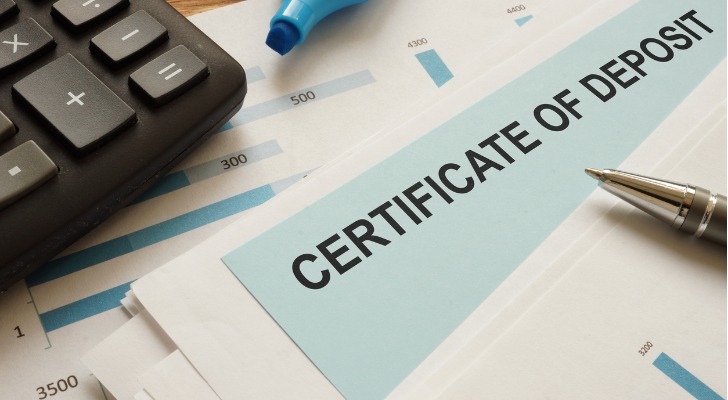A no-penalty certificate of deposit (CD) allows you to withdraw your money before the term ends. This is a feature that standard certificates of deposit lack, making this a more flexible product. However, that flexibility comes at the cost of lower interest rates over the product’s lifetime. This makes these CDs safe with low returns. We’ve detailed how this investment works below. You may want to consult with a financial advisor before investing to make sure this CD is right for your portfolio.
What Is a No-Penalty CD?
A certificate of deposit, or CD, is a type of banking investment product. With a standard CD, you give your money to the bank for a pre-defined period of time. For example, you might purchase a six-month, a one-year or a five-year CD. In each case, you would be depositing your money and committing not to withdraw it for the amount of time on the note; six months, one year or five years, respectively.
To calculate how much interest you could earn with a CD, try using SmartAsset’s CD calculator.
In exchange, the bank pays you a high rate of interest relative to a checking, savings or money market account. For example, at the time of writing the average savings account paid 0.21% interest while a 12-month CD paid 0.71%.
If you withdraw this money before the term is over you pay a penalty. Most, if not all, banks charge this fee based on a portion of the CD’s total interest. For example, you might have a one-year certificate of deposit that charges an early withdrawal penalty of 180 days’ interest. This means that if you withdraw your money before the 12 months are up, you will be charged the value of 180 days’ worth of interest on that account.
A no-penalty certificate of deposit is a product that trades off some of that return for increased flexibility. These products allow you to withdraw your money from the certificate of deposit early without paying a penalty of any kind. In most cases, you can make a no-fee withdrawal starting seven days after opening the account and effective for the lifetime of the product.
Most, if not all, no-penalty certificates of deposit don’t allow you to make a partial withdrawal. In general, you have to take all of your money out and close the account.
Pros and Cons of a No-Penalty Certificate of Deposit

A no-fee certificate of deposit can be right for the right investor and it comes with both pros and cons that can help you decide if it’s a good fit for you. It’s generally considered a safe investment with a limitation in the potential return you can receive over time.
The main advantages of this product are:
Pro #1: Flexibility
The biggest downside to a certificate of deposit is the lock-in period. A no-penalty CD fixes that. If you suddenly need this money, you can access it without paying any kind of cost or penalty. This is particularly useful if an emergency or sudden need crops up. It’s also a useful way to adapt to changing market conditions. If interest rates rise or if the stock market starts doing particularly well, you can take your money out and put it into a stronger investment.
In other words, a no-penalty CD can work very well for general long-term savings. If you aren’t necessarily sure when you’ll need this money, like with an emergency fund or conservative investments during a bear market, a no-penalty CD can let you collect some interest while preserving access as needed.
Pro #2: Safe Investment
No-penalty certificates of deposit are still a good way to make a safe investment. Like their standard CD counterparts, they pay much higher interest rates than a savings account or equivalent product, while also enjoying FDIC protection. For investors who need a safe place to put their money, they’re a strong choice.
The main downside to this product is financial:
Biggest Con: Low Returns
A no-penalty CD pays more than a savings account, but less than a standard certificate of deposit. That’s the tradeoff. Banks offer you flexibility, but they pay you less money because you haven’t made them a commitment. While interest rates on a CD will vary, in general, you can expect rates for a no-penalty CD to be about one point lower than with a standard product.
For many investors the real catch to a no-penalty CD is competition. This product simply may not make sense compared with something like a high-yield savings account. Many high-yield products offer similar interest rates to a no-penalty CD eliminating some of the complexities of a term-based product.
The Bottom Line

A no-penalty CD is a certificate of deposit that allows you to withdraw your money earlier than a traditional CD. While this gives you increased flexibility, it also tends to come at the cost of lower interest rates which means you earn less on your initial investment no matter how long you keep your money in the CD. It’s typically a safe investment that gives you flexibility if you need access to cash but it isn’t considered an investment with a strong return.
Tips for Investing
- Investing in the right assets is a key component of your portfolio’s overall success. It’s a good idea to work with a professional financial advisor to help you determine what that asset allocation should be and you can even let them manage your investments for you. finding a good financial advisor doesn’t have to be difficult. SmartAsset’s free tool matches you with up to three financial advisors who serve your area, and you can interview your advisor matches at no cost to decide which one is right for you. If you’re ready to find an advisor who can help you achieve your financial goals, get started now.
- As we mentioned, one of the biggest catches to a no-penalty CD is that it often gives you the same return as a high-yield banking product. So, you might want to consider a money market account instead.
Photo credit: ©iStock.com/Kubra Cavus, ©iStock.com/Andrii Dodonov, ©iStock.com/small smiles
